Marketing legend Jeff Yoshimura has been a part of a few epic SaaS brands you mighta heard of… Salesforce, AppExchange, Zuora (where he helped drive the brand around the subscription economy movement), Ayasdi, and now Elastic.
In this session led by Emmanuelle Skala, VP Sales at Influitive, Jeff discusses the different takeaways and key lessons that he has learned in his experiences with each of these companies, such as how to build a community around your brand and why sometimes big, crazy ideas might not be so crazy after all.
The grand conclusion? Every experience is unique and special. You can’t simply apply the same rules at every company you work at and expect success in your next venture.
Check out the full transcript below! You can view the slides here.
If you want to see more sessions from 2016, we’re releasing a new one each week. Subscribe here to be notified. And be sure to grab your tickets to the 2017 Annual NOW.
TRANSCRIPT
Emmanuelle Skala: All right, guys. We’re going to get started. This next hour is all about marketing and we have two pretty incredible CMOs and VP of marketing from companies that you’ve heard of coming on stage.
First, I’d like to introduce Jeff Yoshimura. Jeff was one of the very first folks at Salesforce.com in the marketing team. He was there when they were just a small little startup under 300 employees and he helped grow Salesforce to IPO. He was one of the founding team members on the AppExchange team and he helped launch that epic brand.
He’s going to talk about epic brands today. He was one of the founding members of the team at Zuora, and he helped drive that brand around the subscription economy. Now, he’s at Elastic, who powers the developer platform called Elasticsearch and he is running marketing there.
He is here today to talk to us about “Building an Epic Brand.”
By the way, I forgot to introduce myself. Emmanuelle Skala, VP of Sales from Influitive. I all day talk to marketers, so it’s a pleasure to be here with Jeff today. I’m going to hand it over to Jeff. We’re going to take some questions at the end.
[applause]
Jeff Yoshimura: Hello, everybody. Welcome to Thursday. Today is the last day of the event. Super excited to be here today. Thank you for the introduction. I’ve known Emmanuelle and the folks over at Influitive for a long time. Congratulations on all of the great work that you guys are doing on an ecosystem.
There’s a lot of things I could talk about when it comes to building a brand.
Clicker. I’ll go without the clicker.
There’s a lot of things I can talk about building a great brand. The things that I won’t talk about are, I’m not going to talk about marking the pyramids, or brand pyramids, messaging platforms, things that you guys can read about in blogs. You guys can read about these things on HVS. SaaStr does a great job with their blog. First Round Capital does a great job with their blog.
What I am going to talk about are some real live experiences that I’ve had over the past 15 years or so, really helping build four different brands. What’s been really interesting as I reflect on today is every experience has been a little bit different. There’s really no one size fits all formula. There’s a lot of iteration and adaptiveness that you need to take in building your company.
If you’re just starting out in your company, or if you’re at that phase where you’re growing your business from that first 5 million to 10 million in revenue, or if you’re accelerating, hopefully there’s something that each of you can take away from today.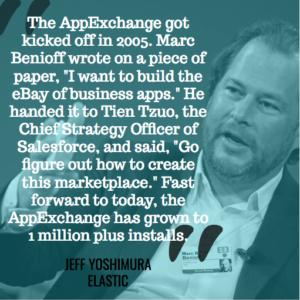
I’m going to start with the AppExchange. The AppExchange was a project that got kicked off in 2005. It was kind of a skunkworks project. Marc Benioff wrote on a piece of paper, “I want to build the eBay of business applications.” He handed that paper to Tien Tzuo who was chief strategy officer, employee number 11, and the first CEO of Salesforce, and said, “Go figure this out. Go figure out how to create this marketplace.” This was pre app store. This was pre any type of marketplace that exists today.
Salesforce was still pretty new. 2005 was the year after the IPO. 2005 was really when the company started to unleash some of the new tools around sforce and building custom scripts. The ability to do integration within the platform. It was really something that was kind of this high in the sky idea. Can you pull this off?
Fast forward to today, the AppExchange has grown to a million plus installs. They just had a 10-year anniversary party about a month ago in San Francisco. A lot of the old members of the team were there.
Some of the things that we learned from that early, early experience was the first 100 apps that we built weren’t really apps. These were apps that we took from the field. These were apps that sales engineers were building. These were apps that professional services people were building. These were apps that some of the early partners were building.
These were simply just ways to get around, at the time, a lot of the deficiencies of Salesforce. Meaning that you couldn’t really customize the application to work for financial services. You couldn’t customize the application to work for media. For high tech manufacturing, Salesforce really didn’t work.
This concept around these packaged applications really became the workaround for a sales engineer, a sales rep, and a customer success team to go and showcase how Salesforce can be extended.
The way that we got our first 100 apps was we went internally. We said, “We need to get 100 apps within 60 days.” We had this massive influx of internal requests from folks. I’m building this app for this use case and that use case. We really curated the concept around the AppExchange internally.
We also did a lot of experimentation. For those of you who recall, there was a building on 101 at 92, and 101 that used to be the old Siebel building.
Salesforce acquired that building. We branded it the AppExchange. There was a little bit of media buzz around, Siebel is dead, this is now Salesforce’s building because that used to be the old Siebel building but we did a lot of experimentation. We had an incubator there in that building.
We had this concept of category experts. We took people from internally within Salesforce to look at the different categories of applications that are going to help drive user adoption of Salesforce. We did things around certification. We did things around online advertising.
When we first launched that marketplace, some of the things that really were special things that we focused on were things around, “Let’s think of the AppExchange as something that is going to help our customers be successful with the deployment of Salesforce.”
Some of the key take aways that we really got from that experience that might be applicable for folks here in this audience is, back in 2005, 2006, this was not a brand.
The AppExchange was just a concept and it was a secondary, maybe even a tertiary brand within Salesforce but the team that was working on the AppExchange, we all believed in Marc’s vision that this was going to be something that would be really, really special.
We treated it like a brand and we invested in ways to make sure that we got the word out. We did a series of launches. When we got the first 100 apps, we did a launch. When we got the next 1,000 apps, we did a launch. We did vertical launches around financial services and media.
We went to large ISVs and recruited big ISVs to go big applications because we knew that if we attracted the big ISVs, it would also attract the smaller developers. We really treated it like a brand and as you’ve seen kind of Dreamforce.
If you’ve been to Dreamforce, grow over time, that brand has also matured in terms of the early days. When the AppExchange launched, we had this program called certification where all the partners would get certified and then we’d say, “Partners, we want you to unleash your press releases on day two of Dreamforce.”
There would just be a flood of press releases. It would be, BigMachines launches on the AppExchange, Eloqua launches on the AppExchange, Marketo launches on the AppExchange. It just created this really spread of buzz around this new ecosystem.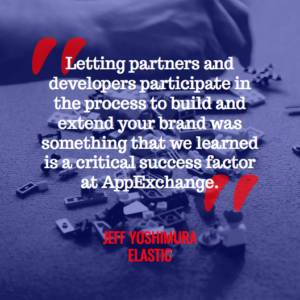
Letting partners participate and developers participate in the building process to help build your brand and extend your brand was something that we really learned as a critical success factor.
Thinking very big. If you look at a lot of the early articles back to 2005 and 2006, there were a lot of people that would say this is a crazy idea. It’s not going to work.
There were a lot sceptics. That said, what we did with all this feedback was we channeled this feedback internally to make that product better, to improve the packaging, to improve the user experience, to improve the customer experience.
Channel all that feedback back into product development and make sure that gets in so that product becomes better and better and more impactful to end users.
I’m going to talk about Zuora. I left Salesforce.com to become one of the first employees at Zuora. Ironically, we incubated Zuora inside of the AppExchange building. Tien Tzuo was employee number 11. He is CEO and co-founder of Zuora. He was my boss and my boss of many, many years.
He came to me and said, “I have this crazy idea. I’m going to leave Salesforce after nine years and start this company Zuora. Marc is going to invest in the company and I want you to be one of my first employees.”
We were out on a business trip out in New York. I said, “Sure, why not? What else am I going to do?” I went off and we started Zuora inside of the AppExchange building in San Mateo . We’d work evenings on a lot of the early concepts.
At Zuora, what we really played around with a lot was messaging and how do we elevate our brand, how do we elevate our messaging. No one really knew of this subscription billing model or subscription business model back in 2007, 2008.
A lot of the great SaaS companies that today are very successful multi-billion dollar companies didn’t even exist. How do you get the word out that the world is different when you run a subscription business?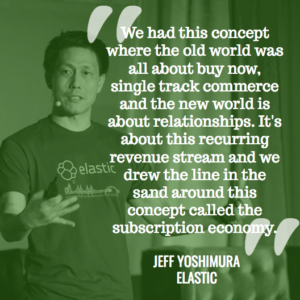
We just really had this concept where the old world is all about buy now, single track commerce, and the new world is about relationships, it’s about this recurring revenue stream, and we really drew the line in the sand around this concept called the subscription economy, and this wasn’t the first thing we came out with. We started with on demand billing, we started with something called subscription billing.
We must have played around with so many different variations before we came up with subscription economy, and it wasn’t until a reporter named Tom Taulli, he writes for Forbes today, great guy. He wrote an article called “The Netflix Economy.” Within that article, he talked about the shift of business models. He referenced Zuora in that article, and that’s where we came up with the idea of subscription economy, and eight years later, this is something that is still being used at Zuora.
One of the other things that we decided that we really needed to do is, if you’ve ever worked for Tien or if you know Tien, he’s a bit crazy. He’s always online, and he’s pinging you with crazy ideas. One night at midnight, he pinged me, and said, “In 48 hours, Apple is going to launch something at Mosconi, so I want you guys to go out there and campaign in front of them.” I was like, “This whole campaign thing is not going to work. We’re not going to protest, put signs up. We’re going to get kicked out, get thrown out on the street.”
This was also the time when social media was just starting out, so what we decided to do was launch a social media campaign around Twitter, and we set up a site called Save Our Press. This was also at a time when Apple was not being too friendly to media companies and publishers, and we were also selling to a lot of media companies, and they were saying, “We want to use Zuora. We don’t want to use this Apple thing. This 30 percent cut isn’t going to work for our business model.”
We dressed up as newsbies, and we created this flyer that was an Onion-like piece, and we went out there before the Apple launched, and we picketed around, and we gave it to all the reporters. This was a press launch, by the way.
We handed these things out to reporters, and they were like, “Who are you guys?” “We’re from Save Our Press. We’re here to save the media industry.” “You sure you’re not from a company?” “No, no, no. We’re from Save Our Press.” Some of the folks that were there that day, Shannon Murray is right there. Katrina Wong. They were on my team, and we pulled this kind of stunt off, and we ended up getting a lot of press. We ended up getting a lot of really good press around what we were doing, and a point of view.
It all pointed back to the subscription economy. It was all about this movement and shift of goods and services to the subscription business model. Have a lot of fun, and think out of the box, and I really have to thank Tien for pushing us to do things like that.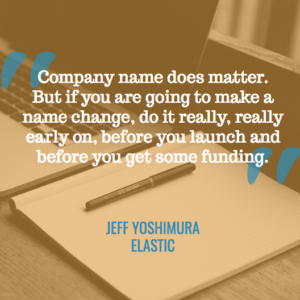
A couple of things in terms of lessons learned at Zuora. Company name does matter. It was not easy creating the brand for Zuora. This whole thing of Z, Zuora. Is it Zuora? Is it Zuora? It was especially hard for salespeople out there making calls. People couldn’t spell it. These were things that we really, really had to work on.
There was contemplation in the early days, should we change the name to something else? We ultimately opted not to do that. We actually polled a couple early customers. They said, “No, we like the Z.”
Later on, as time goes on, it gets harder and harder to change that name, so if you are going to make a name change, do it really, really early on, before you launch. Before you get some funding.
We talked about elevating the message, which doesn’t have to relate just to your products. Subscription economy to Zuora is a high level category.
And then, don’t give up. Tien is one of the hardest working people that I’ve ever met, and he does not give up. He’s always there for the long haul. There were a lot of people that had worked for Zuora, or that were collaborating with us, said, “Subscription economy message is not going to work.” Eight years later, Tien is sitting on CNBC with Jim Cramer, talking about, not Zuora. He’s talking about the subscription economy and how there’s all these different backward trends happening. So, don’t give up if you have an idea that you really like.
Now, I’m going to shift gears to the space that I’m working in today. It’s more the space around Big Data. I had the opportunity to be one of the first people at a company called Ayasdi. They’re really abstract technology that is different than your pure SaaS play application. It’s machine learning, taking all this data inside, and without even asking a question of the data, it pops out what the correlations and the answers are.
This was developed by three mathematicians from Stanford University, and I was the first business hire of this company. It was really raw. It was pre funding. We were working inside of basically a house. It’s Palo Alto.
My job was to figure out how to launch this company, how to get this company off the ground. I’ve got three mathematicians, brilliant people, including the professor of mathematics at Stanford University, and how do you actually go get this company off the ground? Vinod Khosla had already committed to investing the first ten million dollars in the company, and there was also this thing they were doing called topological data analysis. What the heck is topological data analysis? This is no category. How can I launch something like this? No one is ever going to know what this is, or can they even say it.
What we ended up doing was spending a lot of time around, how do we take this really deep mathematical concept, that today is actually the formation of a lot of graph theories and graph networks, which is a really popular thing in the data space, but how do we take this really complex thing that has been around for hundreds of years, and make it really, really simple? What we launched with was something around the concept of, a lot of companies in the space, just take IBM Watson, and we’re talking about finding insights through asking questions of data.
We’ve said, you know what? We’re the anti asking questions of data. With our technology, you don’t have to ask a single question. You throw the data in, and we’re going to get you the answers. It’s a little far-fetched, but we would lead you to where the answers are.
We launched the company about six months after I joined, and we got a ton of coverage. Nobody knew about the company, and I had three mathematicians on the cover of the “Wall Street Journal” in print. They were in “Bloomberg” in a print article. They were on NPR, talking on “Here and Now.”
They were all over the place, and this was at a time when Big Data was just getting started. Our job was to look different than everybody else who was talking about analytics, or insights, and a lot of these common buzzwords you hear in Big Data.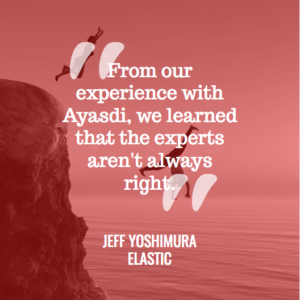
The lessons that we learned from this experience are that experts aren’t always right. When I joined, I was like, “Man, this name’s tough. I already dealt with a Z name. I don’t know if I could deal with an A name, so what do I do?”
I had really two options, because the CEO said, “We have to launch the company, so I don’t want to go through a naming exercise, because I already did that, and I already spent a lot of money doing that.” Before I came on board, given that I was a first business hire, they had paid an agency and invested in resources to actually change the name.
The name that this agency came up with was Phenom. It wasn’t even phenom.com. It was phenom.net.
[laughter]
Jeff: I was like, “Are you crazy?” Then I said to the founders, “How do you guys feel about this name?” They go, “Ah, we’re a little bit uneasy. I know we’re mathematicians and we think we’re brilliant. But this Phenom thing is not a really good play on what we really want to do,” because they’re very humble, down to earth people. Just great people.
Over a weekend, I said, “You know what? We’re killing the name. We’re going to go back to Ayasdi. It has meaning. It means “to seek” in Cherokee Indian. We have the dot com URL. It’s the name that you guys like and feel really, really comfortable with.
We went back to the VCs and said, “OK, guys, we’re not changing the name to Phenom. We’re going back to Ayasdi,” and we shifted gears and pivoted really quickly with about two months before we launched.
We talked about simplifying complexity, which is what we had to do when we’re moving away from this concept of topological data analysis.
The last thing that we did was really work on telling a great media story. These were with three mathematicians from Stanford that had never been inside of a company before. That requires putting the right discipline around training in place, but also rightsizing it for them. There are a lot of folks out there that do media training and there are a lot of great PR people out there. But you need to really rightsize things.
What I did was I looked back at companies that had an academic rooting and I hired a group that trained Diane Green and the team over at VMware, because they were academics. I used them to train the founders of Ayasdi, because that was a great bridge and they felt really, really comfortable being with the trainers because they had worked with people in academics.
We did a road show out in New York and it was two months before launch to get these folks comfortable with some of the media and journalists, people that I knew. Then we ended up launching a month and a half later and the rest is history. The company has gone on to raise about a hundred million dollars in funding and I was there for about the first two years of that.
Where I am today, I’m at Elastic. Elastic is the company behind the open source projects Elasticsearch, Kibana, Logstash, and others. I’m just walking through the hallway. There are a lot of end users. If you folks aren’t developers, maybe your developers are using our technology underneath your systems. I see some of the folks out there like Totango. That’s Elasticsearch under the covers.
With Elastic, what has been unique is, because we are open source, we have a massive community. We’ve had 45 million downloads over the past two and a half years and we have 50,000 community members worldwide.
We have endless numbers of users out there who are willing to tell their story. The platform that I use around building the brand is a little bit different. It’s more about getting users to tell the story and the user stories to talk to other developers and other architects.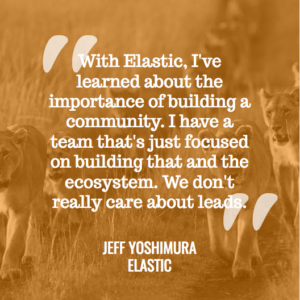
It’s less about telling a business story and trying to get these folks in front of “The New York Times” and “The Wall Street Journal” and Bloomberg, but more about telling a user story that is going to resonate with other people like them.
Elastic powers NASA, for example, which is a pretty exciting story. Four times a day from the NASA Mars Rover, there’s streams of data that comes in to Elasticsearch and they use that data to power all the space missions. There are many, many other stories like that.
With Elastic, the things that I’m learning now that I’ve been here for the past year or so is build a community. I have a team focused just on building the community and building the ecosystem. We don’t really care about leads. In fact, we don’t put these people into our lead gen database. These are community people.
We do about 500 meetups a year around the world and we spread the gospel about Elastic. It comes from the community. The best case is you have somebody from the community run the meetup organization, not somebody from Elastic, not a salesperson, for example, or a marketing person, but somebody who is actually a developer in the community.
We also go out and curate a lot of stories in the wild. We see a lot of things that are happening around the use of our technology. We’ll go get any user story and have these people tell their story and author a blog on our site, or speak at one of our events, or go speak at a meetup.
The one thing that we’re trying to do different here is I have an editorial staff. We’re trying to build a very special voice. Right now, it’s not evident across our site properties and our mediums, but we really, really want to be different. If you talk to our founders, they don’t want to sound like any other data company and they want this personality to be fun and engaging and lively.
We’re doing a user conference next week and a lot of the [laughs] keynote deck is going to insert a lot of the thinking from our founders, where he’s a big movie buff. There’s a lot of quotes and themes from different movies that he wants inside of the keynote.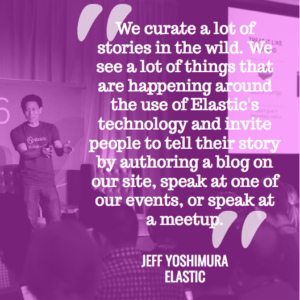
It’s really having this fun play on what we do but, obviously, relating it back to our technology. I make this statement that you have to find the voice and channel that voice of your founders into how you go out there and create your brand. It’s super, super important as you think about the longevity of your company and the longevity of your go to market strategy.
In summary, no experience or company is the same. Every experience is unique. Again, it’s not a one size fits all and really think long and hard about how you want to be different than what you’ve experienced before or how you want to do something different than what you’ve done before.
That’s one of the things that at least I take a lot of focus in terms of where I move from is not taking the same playbook and saying that it’s going to work over and over again, because it usually doesn’t. So being able to adapt.
Brand building takes a lot of time. Salesforce.com in 2008 was not that big of a company. It was 3,000, 3,500 people. Today, it’s 15, 16 thousand people. It wasn’t that big of a company.
Building the brand of Salesforce. Building the brand of AppExchange, it took 10 years to do the AppExchange brand to get it to where it is today. Salesforce took a long time. Building a brand takes time. Remember that it does take time.
Then having the right team. The team could be internal, it could be external resources, but building the right team around you is super important. But aligning that to the right goals that you have for brand building. Is it to generate awareness? Is it lead generation? Is it to launch the company?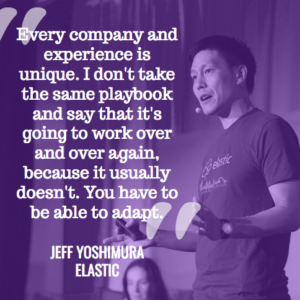
What are those goals? I think making sure that you have alignment to what those goals are is super, super important. Keep iterating. Keep iterating and don’t fire somebody just because they didn’t achieve something. If you hire the right team, work with them. Iterate with them. It’s going to take some time.
Those are the things that I would say in summary and in closing. With that I think we have five minutes or so for questions.
Emmanuelle: That was great, Jeff, thank you. I’m just going to ask one question. I actually want to piggyback off of the end of what you just said. There are a lot of young companies out here. If it’s going to take 5, 10 years to really build your brand, how do you measure that you’re on pace? How do you measure that you’re on track after, let’s say, year one or year two? How do you know that you’re heading in the right direction?
Jeff: I think the first thing you’ve got to do is you’ve got to listen to your customers. You’ve got to listen to your early users and adopters. You’re going to get great feedback from these early folks. Are you on pace?
Obviously, product, brand, market, product market fit, these things all need to come together. But those first three to five years of just listening to your customers or your target customers is super, super important.
We had to do that at Zuora in the early days. In fact, we pivoted. A lot of the early, early customers were really, really tiny startups, but we decided that that wasn’t actually the right set of customers for what we were trying to achieve.
We actually went a little bit upstream and we changed the bar from really selling to companies that had less than a million dollars in revenue to focus on companies that were between a million and five to 10 mil.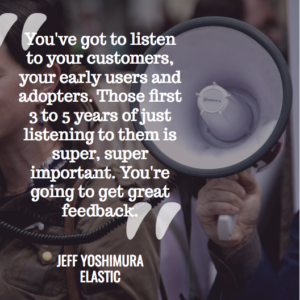
That was all based on the feedback that we heard from our customers, that our system was a little bit too complex for their needs.
Emmanuelle: Try something, listen to your customers, iterate, and keep trying. Awesome. There is some questions out in the audience.
Male Participant: Thank you so much for sharing. For B2B companies that have products that are used by end users as well, how do you draw the line between letting the stories of those end users come up but also having stories of your actual clients come up? Does that question make sense?
Jeff: Yeah. At least for us at Elastic, we don’t really care because we have a massive amount of end users and then our customers are actually pretty large. We have a couple thousand customers. But we don’t discriminate between end users and customers.
What we do want customers to tell is how they are using really what we call our open core model, which are some of our commercial extensions. They’re getting value from our commercial support.
But for end users, we view that there’s a user journey and that a user who starts off as a free user, an open source user, as they mature in their development cycle or as their company matures, they have the potential, if they want to, to become a customer.
We just want to get as many great user stories out there as possible. We actually look at that when we have a user conference, is we want a balance. We don’t want to just have all the paying customers be speakers at our conference.
Emmanuelle: Other questions. Right over there. There’s some mics coming.
Female Participant: Thank you. I have a company name that starts with Z as well, and my investors are concerned because we’ll be at the bottom of all lists. Can you give me your view on that?
Jeff: Going from Z to A was actually nice, because we actually appeared at the top of the list, so that is a valid concern.
That said, I think you can build a great brand with a Z or a Y name. If you just take a consumer property like Yelp, they have a great brand. There’s plenty of other companies that have names at the end of the alphabet that are doing well. I think it’s how you get out there and promote your brand and get the right set of stories out there.
If you have a great name with a Z I wouldn’t worry about it. I would just keep it as is. Trying to find an A name is a little bit crazy. [laughs]
Emmanuelle: We have time for one or two more. There’s one over here.
Male Participant: We heard from one of the other speakers earlier today that as a startup, you’re probably better off hiring talented young people rather than competing for experienced people. Does that work for marketing people as well? You mentioned the people in the press you know. Someone who’s straight out of university ain’t going to know no one.
Jeff: I think in marketing, if you’re just getting started, you can do a couple things. One is you can have a set of advisors that can advise on helping you get your company off the ground. Then you can hire somebody who’s maybe mid-level or someone who’s between just getting started in their career but they’ve seen a little bit of growth, maybe two or three years at a company and they’re going on year four. But they can really take their career off and use this opportunity as a platform.
As long as they have a good network where they can still learn from other people that are either mentors or advisors to them, I think that’s a perfectly fine solution. I don’t think you need to, if you’re just getting started and you’re bootstrapping your company, if you’ve just raised your first one million or two million, you probably don’t need to go hire the VP of marketing out of the gate.
I would focus on how to get product market fit or how do you just get your first 10 to 20 customers in the door if you’re B2B. If you’re B2C, then how do you get your first 1,000 users and learn from that?
Emmanuelle: Let’s thank Jeff. That was epic. I really appreciate it. Thank you.
Jeff: Thank you.
[applause]
You can see all the slides from Jeff’s presentation here.
